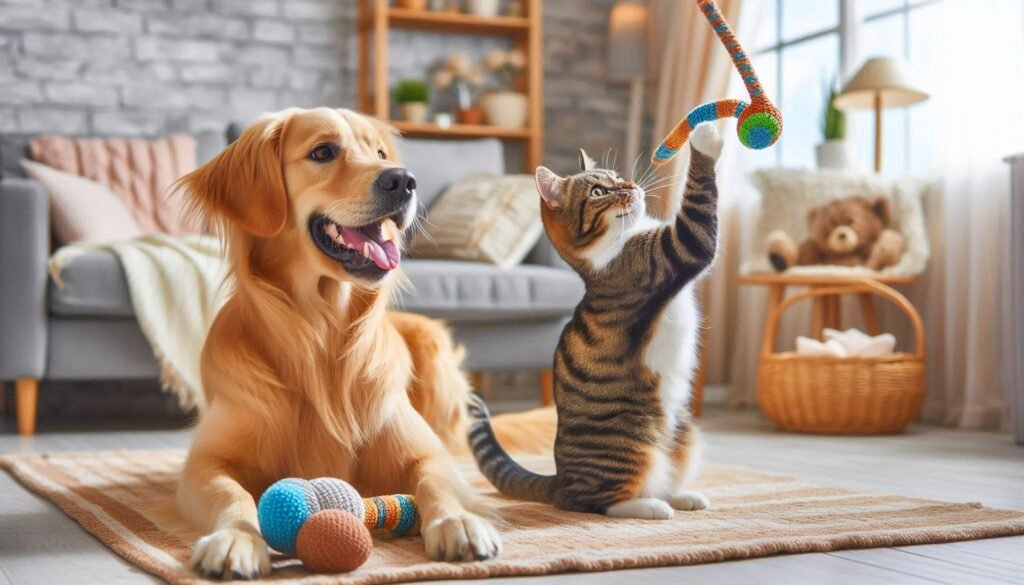Introduction
Understanding pet behavior, particularly in dogs and cats, is crucial for any pet owner. Recognizing the various ways these animals communicate and express their feelings can significantly improve human-pet relationships.
Importance of Understanding Pet Behavior
- Dogs and cats use distinct body language and vocalizations to convey their emotions. These signals can indicate a range of feelings from happiness and contentment to stress and aggression.
- Misinterpreting these signals often leads to misunderstandings, potentially escalating into behavioral issues or strained relationships.
Overview of Pet Communication
- Dogs primarily rely on body language rather than verbal cues. They interpret human body language based on a long history of relationships with humans.
- Cats, on the other hand, use a combination of tail position, vocalizations, and body language to express their emotions.
This article aims to provide valuable insights into understanding dog behavior and cat behavior. By learning how to recognize and interpret these signals accurately, you will be better equipped to foster a deeper connection with your pets.
For instance, if you’re struggling with potty training your dog, understanding their behavior can make the process easier. Additionally, if you’re looking for more tips on pet behavior, our blog offers a wealth of information.
Moreover, if you’re a veterinary practice looking to enhance your online presence, optimizing your Google My Business profile can attract more clients. Our company, AVI Lead Generation, specializes in digital marketing for veterinary practices, aiming to drive sales and create a positive ROI for our clients.
Understanding Dog Behavior
The Role of Body Language in Dog Communication
Dogs primarily communicate through body language. Unlike humans, who rely heavily on verbal communication, dogs use their bodies to express their feelings and intentions. This form of communication includes a range of signals such as tail position, ear orientation, and overall posture. By paying attention to these cues, owners can gain insights into their dog’s emotional state and needs.
Common Dog Behaviors and Their Meanings
Understanding common dog behaviors is essential for interpreting your pet’s actions accurately:
- Wagging Tails: Often misconstrued as a universal sign of happiness, the meaning of a wagging tail depends on its speed and position. A slow wag with a low-held tail can indicate insecurity, while a high-held, fast-wagging tail may signify excitement or agitation.
- Barking: Dogs bark for various reasons, including alerting to danger, seeking attention, or expressing boredom. The pitch and frequency of the bark can provide additional context.
- Growling: Typically seen as a warning signal, growling indicates discomfort or aggression. It’s crucial to address the underlying cause rather than just the symptom.
Signs of Stress in Dogs and How to Identify Them
Recognizing signs of stress in dogs helps prevent escalation into more severe behavioral issues:
- Yawning: Often mistaken for tiredness, yawning can be a stress signal when it occurs in non-sleep-related contexts.
- Turning Away: A dog turning its head or body away from something often signals discomfort or unease.
- Whale Eye: This occurs when a dog shows the whites of its eyes by turning its head slightly away but keeping its gaze fixed on something it perceives as threatening.
By understanding these aspects of canine behavior, pet owners can better respond to their dogs’ needs and foster a healthier relationship. If you’re considering getting a dog, it’s important to select the perfect breed that fits your lifestyle. For any further inquiries or if you need assistance regarding your pet’s behavior or breed selection, feel free to contact us.
Recognizing Dog Signals
Interpreting dog signals effectively requires an understanding of both positive and negative cues. Dogs often use a variety of body language signs to communicate their feelings.
Positive Signals
Positive signals typically indicate that a dog feels safe, content, or playful:
- Relaxed Posture: A dog with loose muscles, a gently wagging tail, and soft eyes is likely feeling relaxed and comfortable in its environment.
- Playful Bow: When a dog stretches its front legs forward while keeping its hindquarters up, it’s inviting play. This playful bow is often accompanied by wagging tails and excited barking.
Negative Signals
Negative signals can indicate stress, anxiety, or discomfort:
- Whale Eye: This occurs when a dog shows the whites of its eyes more prominently. It can be a sign of fear or unease.
- Lip Licking: Often misinterpreted as harmless, frequent lip licking can signal nervousness or stress in dogs.
Importance of Consistency in Communication
Consistency in communication is crucial for effective canine interaction. Dogs rely heavily on interpreting body language alongside verbal cues. Mixed signals can lead to confusion and stress:
- Consistent commands and gestures help dogs understand expectations.
- Observing your dog’s reactions to different cues ensures you are communicating effectively.
Understanding these signals not only helps in strengthening the bond between you and your pet but also aids in addressing behavioral issues early on. Recognizing both positive and negative signals allows for timely interventions, promoting a harmonious living environment for both pets and owners.
For pet owners seeking further assistance with their dog’s behavior or health needs, AVI Lead Generation Pets provides valuable resources including website creation, content creation for veterinary practices, and reputation management services. These services can greatly benefit veterinarians aiming to enhance their online presence while providing essential information about pet care. For more details about the services offered, visit their FAQ page.
Addressing Common Dog Behavior Issues
Understanding and solving dog issues is essential for maintaining a harmonious household. Common behavior problems in dogs include anxiety, aggression, and excessive barking. Each issue requires a tailored approach to manage effectively.
Anxiety in Dogs
Anxiety in dogs manifests through behaviors such as whining, pacing, and destructive chewing. To address anxiety:
- Create a Safe Space: Provide a designated area where your dog can retreat when feeling stressed. This space should be quiet and filled with familiar items like toys and blankets.
- Reward-Based Training: Use positive reinforcement to encourage calm behavior. Reward your dog with treats or praise when they display relaxed behaviors. Implementing proper pet training tactics can significantly help in this aspect.
Aggression
Aggression can be triggered by fear, territorial instincts, or frustration. Strategies to manage aggression involve:
- Understanding Triggers: Identify what causes aggressive responses in your dog. Common triggers could be specific people, other animals, or certain situations.
- Behavior Modification Techniques: Implement techniques such as desensitization and counter-conditioning. Gradually expose your dog to their triggers in controlled settings while rewarding non-aggressive behavior.
Excessive Barking
Excessive barking can stem from boredom, anxiety, or alertness. To reduce this behavior:
- Mental Stimulation: Keep your dog mentally engaged with interactive toys and puzzle feeders.
- Consistent Training: Teach commands like “quiet” and reward compliance consistently. Again, utilizing effective pet training strategies will aid in this process.
Addressing these common behavior problems requires patience and consistency. By understanding the underlying causes of these issues and applying appropriate strategies, you can help your dog lead a more balanced life.
Understanding Cat Behavior
Differences Between Cat and Dog Communication Styles
Cats and dogs have distinct ways of communicating, reflecting their different evolutionary paths and social structures. While dogs often use body language to communicate with humans, cats rely on a combination of vocalizations, tail position, and body language. Unlike dogs, cats are solitary hunters by nature, which influences their more subtle and nuanced communication methods.
Key Behaviors in Cats and Their Meanings
Understanding feline communication involves interpreting various behaviors:
- Tail Position: A cat’s tail can reveal much about its mood:
- Upright Tail: Indicates friendliness or curiosity.
- Puffed-Up Tail: Sign of fear or aggression.
- Tucked Tail: Suggests insecurity or anxiety.
- Purring: Commonly associated with contentment, though it can also signify discomfort or pain in certain contexts.
- Slow Blinking: Often a sign of trust and affection towards humans.
Misinterpretations of Cat Behaviors by Pet Owners
Misunderstandings frequently arise due to the differences in how cats and dogs express their emotions. Some common misinterpretations include:
- Ignoring Slow Blinks: Many pet owners overlook slow blinking as a gesture of friendship.
- Misreading Vocalizations: Cats use a variety of vocal sounds like meowing, chirping, and hissing. Each sound has a different meaning that can be context-dependent.
- Overlooking Body Language Signals: Subtle cues such as flattened ears or dilated pupils often go unnoticed, leading to misinterpretations of a cat’s emotional state.
Recognizing these behaviors is crucial for fostering a harmonious relationship with your feline companion.
The Role of Veterinary Practices in Understanding Cat Behavior
Veterinary practices play a significant role in helping pet owners understand their animals better. By providing resources such as engaging veterinary blog content that explains common cat behaviors and their meanings, vets can help reduce misunderstandings between cats and their owners.
Moreover, as we move into 2024, it’s essential for veterinary practices to adapt their marketing strategies to reach more pet owners effectively. The Ultimate Guide to Marketing Your Veterinary Practice in 2024 offers valuable insights into how veterinarians can leverage digital platforms to connect with pet owners.
Additionally, promotional offers can also play a key role in attracting new clients to veterinary practices. Implementing proven promotional offers can help foster a sense of community and build trust between the veterinary practice and pet owners.
Recognizing Cat Signals
Understanding feline body language is essential for interpreting cat signals accurately. Cats have a unique way of expressing their emotions, which can be deciphered through their physical actions and postures.
Positive Signs in Cats
Cats exhibit several behaviors that indicate they are content and comfortable:
- Slow Blinking: When a cat slowly blinks at you, it is often referred to as a “cat kiss.” This gesture signifies trust and affection.
- Kneading: This action involves a cat rhythmically pressing its paws against a soft surface. It is a comforting behavior often linked to kittenhood when they knead their mother’s belly to stimulate milk flow.
Negative Signs Indicating Distress or Aggression
Recognizing signs of distress or potential aggression can prevent negative interactions and ensure the cat’s well-being:
- Flattened Ears: When a cat’s ears are pressed back against its head, it indicates fear, anxiety, or aggression.
- Hissing: This vocalization is a clear sign that the cat feels threatened and is warning others to stay away.
The Importance of Respecting a Cat’s Personal Space
Respecting a cat’s personal space is vital for building trust and ensuring they feel safe. Unlike dogs, cats may not always seek out human interaction and can become stressed if their boundaries are ignored.
- Observe their behavior closely and allow them to approach you on their terms.
- Provide hiding spots where they can retreat if they feel overwhelmed.
By paying attention to these signals, pet owners can better understand their feline friends, leading to more harmonious relationships.
Addressing Common Cat Behavior Issues
Common Issues: Scratching Furniture and Litter Box Problems
Scratching Furniture
Cats often scratch furniture to mark territory, sharpen claws, or stretch muscles. This natural behavior can become problematic indoors. While some may consider declawing as a solution, it’s important to understand the negative implications this procedure can have on a cat’s well-being.
Litter Box Problems
Inappropriate elimination can stem from various causes including medical issues, stress, or dissatisfaction with the litter box setup.
Techniques for Modifying Unwanted Behaviors
Providing Appropriate Scratching Posts
- Type: Offer various textures like sisal, cardboard, or carpet.
- Placement: Position scratching posts near favorite resting spots or previously scratched areas.
- Encouragement: Use catnip or toys to attract your cat to the post.
Despite providing scratching posts, some cats may still prefer furniture. It’s a common misconception that trimming a cat’s nails will stop them from scratching furniture. However, this behavior is more about their instinct, and providing suitable alternatives is often more effective than trying to change their natural tendencies.
Improving Litter Box Habits
- Cleanliness: Maintain a clean litter box by scooping daily and changing litter regularly.
- Location: Place the litter box in a quiet, accessible area.
- Quantity: Provide one more box than the number of cats in your household (e.g., two boxes for one cat).
Tips for Improving the Relationship with Your Cat Through Training
Positive Reinforcement
Reward desired behaviors like using a scratching post or proper litter box use with treats and praise.
Clicker Training
Use clicker training to reinforce positive actions. A click followed by a treat helps cats associate the sound with good behavior.
Interactive Play
Engage in regular play sessions to strengthen your bond and reduce stress-related behaviors. Utilize toys that mimic prey to stimulate your cat’s hunting instincts.
By addressing common behavioral problems in cats proactively and compassionately, you can foster a harmonious environment that encourages positive interactions.
Enhancing Human-Pet Relationships
Building trust through consistent interactions
Establishing a strong bond with pets relies on consistent, positive interactions. Regular routines and predictable behavior from pet owners help animals feel secure. Simple actions like feeding at the same time each day, regular walks for dogs, and daily playtime for cats can foster trust. Pets thrive on routine and knowing what to expect from their human companions.
Understanding pet communication for better bonding
Comprehending the nuances of pet communication is crucial for strengthening relationships. Recognizing and responding appropriately to body language signals—such as a dog’s wagging tail or a cat’s slow blink—can enhance mutual understanding. Misinterpretations can lead to stress or behavioral issues, so it’s essential to learn what different gestures and sounds mean in the context of each species.
Resources for learning more about canine and feline body language
To deepen understanding of pet behavior, consider exploring various educational resources:
- Books
- “The Other End of the Leash” by Patricia McConnell
- “Decoding Your Dog” by the American College of Veterinary Behaviorists
- “Cat Sense” by John Bradshaw
- Online Courses
- Karen Pryor Academy: Offers courses on animal training and behavior.
- Dog Decoder App: A visual learning tool for dog body language.
- Cat Caregivers Guide: Provides insights into feline behavior.
- Professional Advice
- Consulting with a certified animal behaviorist or a veterinarian specializing in behavioral science can provide personalized guidance tailored to individual pets.
In addition to these resources, you can find more recommendations for vendors who specialize in pet-related services at AVI Lead Generation Pets.
Investing time in understanding pet communication not only improves relationships but also ensures the well-being and happiness of both pets and their owners.
Conclusion
Observing pets closely is crucial for fostering a deeper understanding of their behavior. Recognizing and interpreting pet behaviors can significantly enhance the relationship between humans and their furry companions.
- Encourage consistent observation: Pay attention to the subtle cues and signals that your dog or cat exhibits.
- Value the importance of interpretation: Knowing what different behaviors mean can help in addressing issues promptly and effectively.
Understanding pet behavior, as discussed in “Understanding Pet Behavior: What Your Dog or Cat Is Really Trying to Tell You,” is essential for creating a harmonious living environment. By investing time in learning their body language and signals, you ensure a happier, healthier relationship with your pets.
For those looking to deepen their understanding of pet behavior and improve their relationship with their furry friends, resources such as AVI Lead Generation Pets provide valuable insights. They offer a range of services including website creation, content creation, social media management, paid ads, and reputation management specifically tailored for veterinarians.
Moreover, if you’re a veterinarian seeking to enhance client engagement through effective lead magnet strategies, the article on Veterinary Lead Magnet Strategies for Client Engagement could be beneficial.
Additionally, veterinarians can utilize owner guides provided by AVI Lead Generation Pets. These guides are designed to assist veterinary practices with easily branded materials ready to use from day one.
Whether you’re a pet owner striving to understand your pet better or a veterinarian aiming to connect more effectively with clients, there’s a wealth of resources available that can help you achieve these goals.
FAQs (Frequently Asked Questions)
Why is it important to understand pet behavior in dogs and cats?
Understanding pet behavior is crucial as it helps improve the human-pet relationship. By recognizing how pets communicate their feelings, owners can respond appropriately to their needs, leading to a happier and healthier environment for both pets and humans.
What are some common dog behaviors and what do they mean?
Common dog behaviors include wagging tails, which typically indicate happiness; barking, which can signal alertness or a desire for attention; and growling, which may express discomfort or warning. Recognizing these signals helps owners understand their dog’s emotional state.
How can I identify signs of stress in my dog?
Signs of stress in dogs can include yawning, turning away from stimuli, excessive panting, and pacing. Being aware of these signs allows owners to take action to alleviate their dog’s anxiety, ensuring their well-being.
What are positive and negative signals in cat communication?
Positive signals in cats include slow blinking and kneading, indicating comfort and affection. Negative signals may involve flattened ears or hissing, suggesting distress or aggression. Understanding these signals is essential for maintaining a respectful relationship with your cat.
What techniques can help address common cat behavior issues?
To address common cat behavior issues like scratching furniture or litter box problems, provide appropriate scratching posts and ensure the litter box is clean and accessible. Training techniques that encourage positive behavior can also strengthen the bond between you and your cat.
How can I enhance my relationship with my pet?
Building trust through consistent interactions is key to enhancing your relationship with your pet. Understanding their communication styles fosters better bonding. Observing your pet closely will allow you to interpret their behaviors more accurately, leading to a deeper connection.








